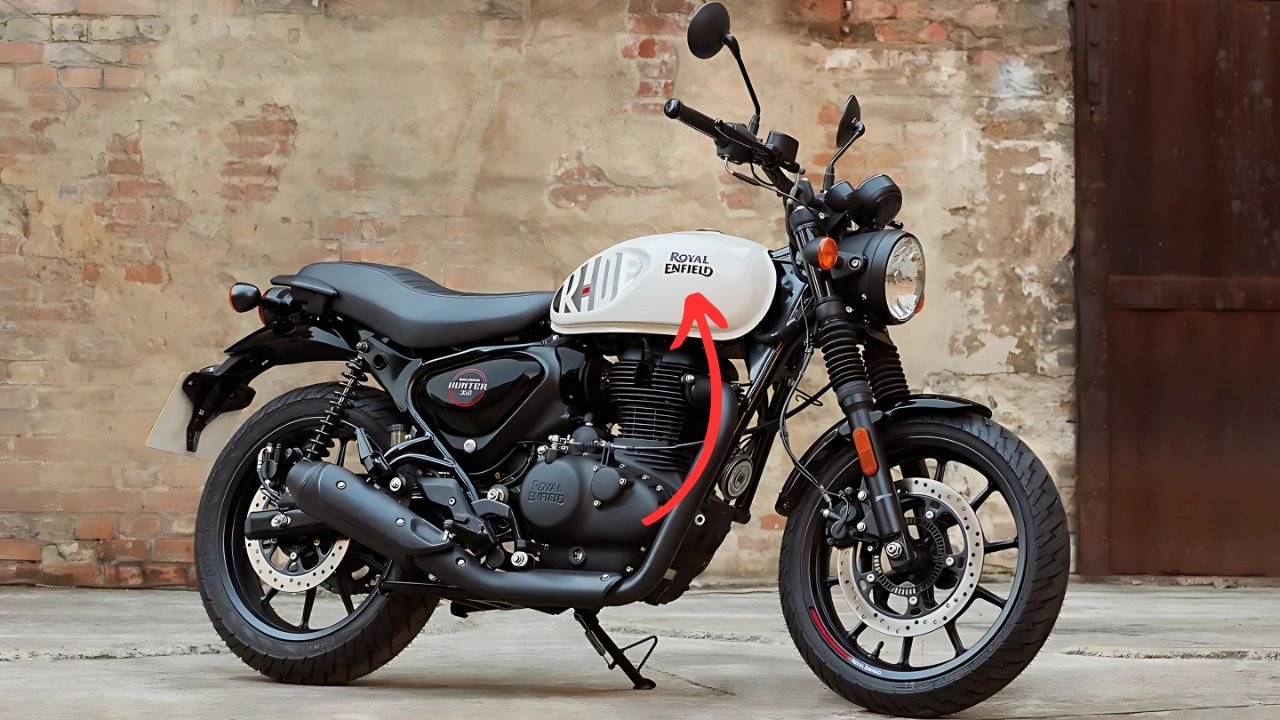Royal Enfield Hunter 350: In the evolving motorcycle landscape, Royal Enfield has strengthened its position with the Hunter 350, a model that successfully bridges the gap between the brand’s heritage appeal and modern urban riding requirements.
This thoughtfully designed motorcycle maintains Royal Enfield’s distinctive character while introducing a more accessible, nimble platform that appeals to both new riders and experienced enthusiasts seeking a versatile city companion.
Design Philosophy
The Royal Enfield Hunter 350 embraces a design approach that balances classic styling with contemporary proportions.
While clearly belonging to the Royal Enfield family, the Hunter adopts a more compact stance with a shorter wheelbase and reduced overall dimensions compared to its siblings like the Classic 350 and Meteor 350.
This creates a motorcycle that maintains brand identity while introducing a sportier, more urban-focused aesthetic.
The teardrop fuel tank, circular headlamp, and minimalist side panels pay homage to timeless motorcycle design while contemporary touches like LED lighting elements, stylish alloy wheels on higher variants, and vibrant color options create visual distinction.
The thoughtfully designed single-piece seat maintains rider comfort while contributing to the clean, uncluttered lines that define the motorcycle.
Available in several attractive color schemes including Rebel Blue, Rebel Red, and Rebel Black with distinctive graphics packages, the Hunter 350 offers visual personalization that appeals to diverse consumer preferences.
The overall design successfully balances Royal Enfield’s heritage with urban sensibilities, creating a motorcycle that looks appropriate in both city streets and weekend getaways.
Engine and Performance
Powering the Hunter 350 is Royal Enfield’s J-series 349cc single-cylinder engine, also found in the Meteor and Classic models.
This air-cooled powerplant produces 20.2 horsepower at 6,100 rpm and 27 Nm of torque at 4,000 rpm—modest figures on paper that translate to accessible, usable performance in real-world riding conditions.
The engine character prioritizes mid-range torque over outright power, delivering linear acceleration and relaxed cruising capability.
The five-speed transmission provides well-spaced ratios that complement the engine’s torque characteristics, while the light clutch action reduces fatigue during city riding with frequent gear changes.
What distinguishes the Hunter’s riding experience from other Royal Enfield models is its more responsive throttle mapping and slightly sportier engine tuning that enhances urban rideability.
The characteristic thump remains—albeit slightly muted compared to older Royal Enfield models—providing the auditory experience enthusiasts expect while meeting modern emission standards.
Chassis and Handling
The chassis represents perhaps the most significant departure from traditional Royal Enfield models, with the Hunter 350 built around a modified version of the J-platform frame with revised geometry that prioritizes agility and maneuverability.
The 17-inch wheels at both ends (compared to the 19-inch front wheel found on most Royal Enfield models) contribute to quicker steering response and improved handling dynamics.
Suspension duties are handled by conventional telescopic forks with 130mm travel up front and twin shock absorbers with 102mm travel at the rear.
This setup strikes a balance between comfort and control, absorbing urban road imperfections effectively while maintaining stability during cornering and high-speed cruising.
Braking performance comes through a 300mm disc with dual-piston caliper up front and a 270mm disc with single-piston caliper at the rear, both managed by dual-channel ABS on premium variants.
This braking package provides confident stopping power appropriate for the motorcycle’s weight and performance capabilities.
The 800mm seat height makes the Hunter accessible to riders of various statures, while the compact dimensions and 177kg wet weight (14kg lighter than the Classic 350) create a motorcycle that feels significantly more manageable in urban environments.
The reduced turning radius particularly enhances maneuverability in congested traffic and tight parking situations.
Ergonomics and Comfort
The riding position strikes a balance between upright comfort and engaged control, with moderately rear-set footpegs and a natural reach to the handlebar that places the rider in a neutral posture.
This ergonomic triangle proves comfortable for both urban commuting and occasional longer journeys, though the compact dimensions may feel less spacious for taller riders on extended trips.
The well-padded seat provides reasonable comfort for city rides and short tours, while the balanced suspension tuning prevents harshness over urban obstacles.
Wind protection remains minimal—as expected from a naked roadster—limiting sustained high-speed comfort, though this aligns with the motorcycle’s intended urban and short-distance focus.
Passenger accommodation receives appropriate attention with adequate seat space and conveniently positioned grab rails, though the compact dimensions naturally provide less expansive accommodation than larger touring-oriented models in the Royal Enfield lineup.
Technology and Features
The Hunter 350 incorporates modern features while maintaining a mechanical, analog character that aligns with Royal Enfield’s brand identity.
The instrument cluster varies by variant, with higher trims featuring a digital-analog combination that provides essential information including fuel level, gear position indicator, and trip computer alongside the traditional speedometer.
The Tripper navigation pod—Royal Enfield’s turn-by-turn navigation system that pairs with smartphones—is available as an accessory, allowing riders to add connected functionality without compromising the classic aesthetic.
LED lighting elements enhance both visibility and modern appearance, while USB charging ports on premium variants address contemporary device requirements.
Safety features include standard dual-channel ABS on higher variants (single-channel on base models), hazard warning lights, and the inherent stability of the chassis design.
These elements create a balanced package that incorporates essential modern features without overwhelming technology that would detract from the pure riding experience.
Market Position
The Hunter 350 occupies a strategic position in Royal Enfield’s expanding portfolio, serving as an accessible entry point that introduces new riders to the brand while providing a more urban-focused option for existing enthusiasts.
This positioning allows Royal Enfield to address changing market preferences while maintaining the heritage and character that distinguish the brand from more performance-focused competitors.
Priced competitively, the Hunter 350 creates an attractive value proposition that combines Royal Enfield’s established quality and character with improved urban usability.
This balance has proven successful in attracting younger riders and urban dwellers who might previously have found traditional Royal Enfield models too heavy or unwieldy for city environments.
Royal Enfield Hunter 350:
The Royal Enfield Hunter 350 represents a thoughtful evolution of the brand’s approach, delivering the distinctive Royal Enfield experience in a more accessible, urban-friendly package.
By maintaining core brand values—torquey single-cylinder engine, timeless styling, and mechanical character—while introducing improved handling dynamics and modern features, Royal Enfield has created a motorcycle that bridges traditional appeal with contemporary requirements.
For riders seeking an authentic motorcycling experience with practical urban capabilities, the Hunter 350 presents a compelling option that demonstrates Royal Enfield’s ability to evolve while honoring its heritage.

